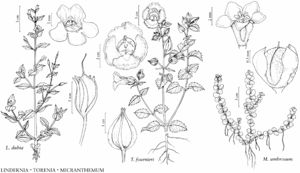Difference between revisions of "Torenia fournieri"
Ill. Hort. 23: 129, plate 249. 1876.
FNA>Volume Importer |
imported>Volume Importer |
||
| (One intermediate revision by the same user not shown) | |||
| Line 30: | Line 30: | ||
|elevation=20–1200 m. | |elevation=20–1200 m. | ||
|distribution=Ala.;Fla.;Iowa;La.;N.C.;Asia;introduced also in Mexico;Central America;South America;Europe;Australia. | |distribution=Ala.;Fla.;Iowa;La.;N.C.;Asia;introduced also in Mexico;Central America;South America;Europe;Australia. | ||
| + | |introduced=true | ||
|discussion=<p><i>Torenia fournieri</i> and its hybrid with T. concolor, often called “<i>Torenia</i> hybrida” in the horticultural trade, are popular bedding plants throughout much of North America. The hybrid is sterile, reportedly producing neither seeds nor viable pollen (http://www.health.gov.au/internet/ogtr/publishing.nsf/Content/torenia-3/$FILE/biologytorenia08.pdf). J. D. Pittillo and A. E. Brown (1988) published the first report of <i>T. fournieri</i> as a waif in the flora area, from Jackson County, North Carolina.</p> | |discussion=<p><i>Torenia fournieri</i> and its hybrid with T. concolor, often called “<i>Torenia</i> hybrida” in the horticultural trade, are popular bedding plants throughout much of North America. The hybrid is sterile, reportedly producing neither seeds nor viable pollen (http://www.health.gov.au/internet/ogtr/publishing.nsf/Content/torenia-3/$FILE/biologytorenia08.pdf). J. D. Pittillo and A. E. Brown (1988) published the first report of <i>T. fournieri</i> as a waif in the flora area, from Jackson County, North Carolina.</p> | ||
|tables= | |tables= | ||
| Line 54: | Line 55: | ||
|publication year=1876 | |publication year=1876 | ||
|special status=Introduced;Illustrated | |special status=Introduced;Illustrated | ||
| − | |source xml=https:// | + | |source xml=https://bitbucket.org/aafc-mbb/fna-data-curation/src/2e0870ddd59836b60bcf96646a41e87ea5a5943a/coarse_grained_fna_xml/V17/V17_75.xml |
|genus=Torenia | |genus=Torenia | ||
|species=Torenia fournieri | |species=Torenia fournieri | ||
Latest revision as of 20:36, 5 November 2020
Stems 2–38 cm. Leaves: petiole 3–21 mm; blade lanceolate to ovate or distal sometimes linear, 3–46 × 2–24 mm; distal well developed or greatly reduced. Pedicels 5–24 mm, 0.7–1.5 times subtending leaves. Flowers: sepals 11–18 mm; corolla adaxial lip equal to abaxial. Capsules narrowly ellipsoid, 8–12 × 1.5–3 mm. Seeds 0.5–0.6 × 0.3–0.4 mm. 2n = 18 (India).
Phenology: Flowering May–Oct.
Habitat: Lawns, compost piles, roadsides, disturbed places, persisting after cultivation.
Elevation: 20–1200 m.
Distribution
Introduced; Ala., Fla., Iowa, La., N.C., Asia, introduced also in Mexico, Central America, South America, Europe, Australia.
Discussion
Torenia fournieri and its hybrid with T. concolor, often called “Torenia hybrida” in the horticultural trade, are popular bedding plants throughout much of North America. The hybrid is sterile, reportedly producing neither seeds nor viable pollen (http://www.health.gov.au/internet/ogtr/publishing.nsf/Content/torenia-3/$FILE/biologytorenia08.pdf). J. D. Pittillo and A. E. Brown (1988) published the first report of T. fournieri as a waif in the flora area, from Jackson County, North Carolina.
Selected References
None.
